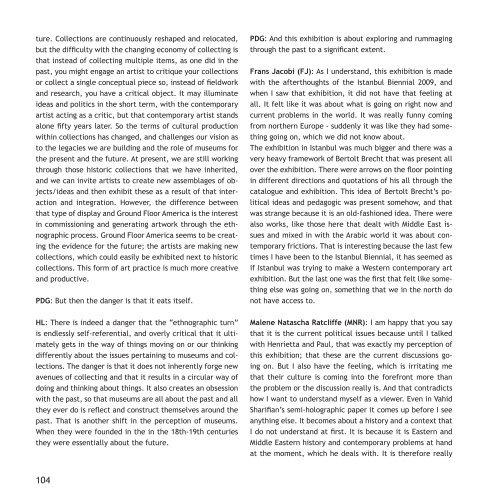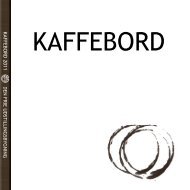læs bogen her - Den Frie
læs bogen her - Den Frie
læs bogen her - Den Frie
You also want an ePaper? Increase the reach of your titles
YUMPU automatically turns print PDFs into web optimized ePapers that Google loves.
ture. Collections are continuously reshaped and relocated,<br />
but the difficulty with the changing economy of collecting is<br />
that instead of collecting multiple items, as one did in the<br />
past, you might engage an artist to critique your collections<br />
or collect a single conceptual piece so, instead of fieldwork<br />
and research, you have a critical object. It may illuminate<br />
ideas and politics in the short term, with the contemporary<br />
artist acting as a critic, but that contemporary artist stands<br />
alone fifty years later. So the terms of cultural production<br />
within collections has changed, and challenges our vision as<br />
to the legacies we are building and the role of museums for<br />
the present and the future. At present, we are still working<br />
through those historic collections that we have in<strong>her</strong>ited,<br />
and we can invite artists to create new assemblages of objects/ideas<br />
and then exhibit these as a result of that interaction<br />
and integration. However, the difference between<br />
that type of display and Ground Floor America is the interest<br />
in commissioning and generating artwork through the ethnographic<br />
process. Ground Floor America seems to be creating<br />
the evidence for the future; the artists are making new<br />
collections, which could easily be exhibited next to historic<br />
collections. This form of art practice is much more creative<br />
and productive.<br />
PDG: But then the danger is that it eats itself.<br />
HL: T<strong>her</strong>e is indeed a danger that the “ethnographic turn”<br />
is endlessly self-referential, and overly critical that it ultimately<br />
gets in the way of things moving on or our thinking<br />
differently about the issues pertaining to museums and collections.<br />
The danger is that it does not in<strong>her</strong>ently forge new<br />
avenues of collecting and that it results in a circular way of<br />
doing and thinking about things. It also creates an obsession<br />
with the past, so that museums are all about the past and all<br />
they ever do is reflect and construct themselves around the<br />
past. That is anot<strong>her</strong> shift in the perception of museums.<br />
When they were founded in the in the 18th-19th centuries<br />
they were essentially about the future.<br />
104<br />
PDG: And this exhibition is about exploring and rummaging<br />
through the past to a significant extent.<br />
Frans Jacobi (FJ): As I understand, this exhibition is made<br />
with the afterthoughts of the Istanbul Biennial 2009, and<br />
when I saw that exhibition, it did not have that feeling at<br />
all. It felt like it was about what is going on right now and<br />
current problems in the world. It was really funny coming<br />
from nort<strong>her</strong>n Europe - suddenly it was like they had something<br />
going on, which we did not know about.<br />
The exhibition in Istanbul was much bigger and t<strong>her</strong>e was a<br />
very heavy framework of Bertolt Brecht that was present all<br />
over the exhibition. T<strong>her</strong>e were arrows on the floor pointing<br />
in different directions and quotations of his all through the<br />
catalogue and exhibition. This idea of Bertolt Brecht’s political<br />
ideas and pedagogic was present somehow, and that<br />
was strange because it is an old-fashioned idea. T<strong>her</strong>e were<br />
also works, like those <strong>her</strong>e that dealt with Middle East issues<br />
and mixed in with the Arabic world it was about contemporary<br />
frictions. That is interesting because the last few<br />
times I have been to the Istanbul Biennial, it has seemed as<br />
if Istanbul was trying to make a Western contemporary art<br />
exhibition. But the last one was the first that felt like something<br />
else was going on, something that we in the north do<br />
not have access to.<br />
Malene Natascha Ratcliffe (MNR): I am happy that you say<br />
that it is the current political issues because until I talked<br />
with Henrietta and Paul, that was exactly my perception of<br />
this exhibition; that these are the current discussions going<br />
on. But I also have the feeling, which is irritating me<br />
that their culture is coming into the forefront more than<br />
the problem or the discussion really is. And that contradicts<br />
how I want to understand myself as a viewer. Even in Vahid<br />
Sharifian’s semi-holographic paper it comes up before I see<br />
anything else. It becomes about a history and a context that<br />
I do not understand at first. It is because it is Eastern and<br />
Middle Eastern history and contemporary problems at hand<br />
at the moment, which he deals with. It is t<strong>her</strong>efore really



